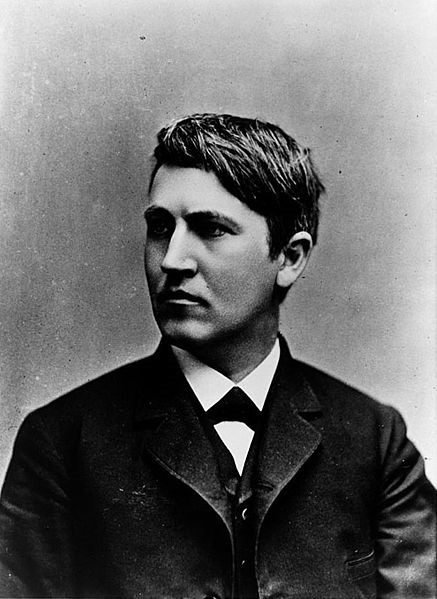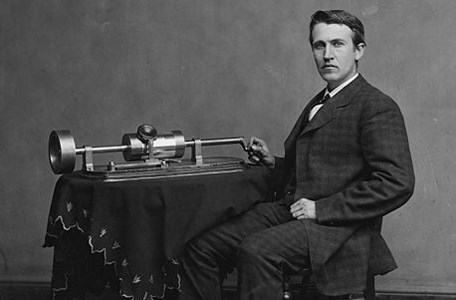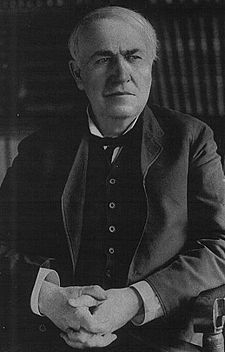“I haven’t failed, I’ve just found 10,000 ways that don’t work,” is one of Thomas Alva Edison’s well-known quotes. This quote describes him very well- he stopped at nothing in his way to reach his goals. Thomas Edison was born February 11th, 1847, in the small village of Milan, Ohio. He moved to Port Huron, Michigan at a young age and spent most of his childhood there. He worked as a merchandise seller on a train, but was granted a job as a telegrapher at the age of 19. After he was fired, he moved into a fellow telegrapher’s basement, where, at the age of 22, developed his first invention, the electric vote counter. In 1887, after deciding his basement was too small, he moved to Menlo Park, New Jersey, where he built the first research lab in history. Most of his inventions were created there. Afterwards, he moved again to West Orange, New Jersey, befriending Henry Ford and working to find a reliable source of rubber. Throughout his 84-year-old life, he developed many useful inventions, as well as made many improvements to existing products. Edison held 1,093 US patents in his name, giving him the record of Most US Patents at that time. Although Edison is best known for his contributions to society, his perseverance should be recognized for never giving up, even at times when failure was imminent. Thomas Edison’s dedication, along with his creative and caring mind, produced countless inventions and improvements that greatly affected modern American lifestyles.
 |
| Thomas Edison at 31 years old (Wikipedia) |
Edison displayed his natural creativity when he was a young child. His creative mind led him to developing several inventions that have greatly influenced our lives. For example, the invention of the electric incandescent light bulb has improved our lives by providing a stable, convenient source of light. The light bulb allows people to work during periods of darkness, or in places where there may be inadequate lighting. It reduces the risk of an accident, since a light bulb is protected by glass while a candle flame is exposed to its environment. Also, the filament in a light bulb can glow for over 1500 hours, whereas even the largest candles might completely burn up in less than 15 hours (Lighting Electrical). Because a light bulb produces significant amounts of light even after sunset, work efficiency is drastically increased because it allows a worker more hours in a day to work on a project. Also, since a light bulb is small and convenient, workers may not have to relocate as much as before to find suitable light conditions to work on something. The fact that the light of a light bulb is contained inside a glass minimizes fire dangers, while candles, which had exposed flames, could easily tip over and cause a disaster. Apart from fire prevention, light bulbs improve safety at night by allowing a person to identify any possible dangers in the surrounding areas. Unlike traditional candles, light bulbs do not have to be replaced as often, which saves the time needed to change candles, as well as the money needed to purchase new candles. But the light bulb was just one of Edison’s many fascinating accomplishments. Another important invention by Thomas Edison was the alkaline battery. It was the first product in history that had the amazing ability to store energy (UC Santa Cruz). It’s small size and ease of use made it a convenient source of energy, and it became a very useful tool in life-threatening emergencies (All About Batteries). Most energy production sources produced energy that had to be consumed very quickly; otherwise it would be wasted. The alkaline battery eliminated this inconvenience by allowing energy to be stored for long periods of time. Its small, light shape makes it easy to carry. Ordinary people now had portable energy supplies that could be taken with them anywhere they went. In emergencies, batteries could save lives by supplying power to run safety equipment when a power outlet is not available. With the electric light bulb, alkaline battery, and several others of his inventions, Edison has developed very useful tools that have revolutionized everyday life.
 |
| Thomas Edison with his first phonograph, in 1877 (Conservapedia) |
Despite the fact that Edison came up with countless improvements to our daily lives, he could not have succeeded if he did not have his instinctive perseverance. Thomas Edison faced many challenges in his life, beginning with his education as a young child. Edison often lost his focus during class, and his teacher became so frustrated that she talked to Edison’s mother, requesting that he be placed in special classes. Edison was sent home after attending school for only 3 months. His mother taught him for a brief 5 years, but he learned to read mostly by himself. He enjoyed learning about chemicals and experimented with them whenever he could (Thomas Alva Edison.org). Although he got kicked out of school and his solid childhood education had gone out the window, Edison did not stop trying to learn. He taught himself how to read, and tried to learn everything he could about chemicals. Experimenting with chemicals motivated him to learn more and more. But along with his education challenges came even bigger obstacles in his career. There were times during Edison’s experiments when failure was repetitive to the point where it was almost expected. When building the light bulb, Edison had a hard time finding the right material to use as filament. He worked for two full years, working as many as 16 hours a day, trying one material after the next only to find it didn’t work. During this time, Edison failed over 6,000 times before finding the best material for his light bulb (Thomas Edison- Successful Failure). Edison’s determination to making a light bulb kept him from giving up. He believed that each failure only brought him one stop closer to success. Failure came many, many times, but he never gave up. And it was because he never gave up, that he finally found success. After two years of experimenting, trying thousands of different materials, Edison had succeeded in making a light bulb that could shine brightly in the night. Had he decided to give up experimenting, he would have never held the honor of manufacturing the world’s first electric light bulb. There were many obstacles in Edison’s life, including poor education and continued failures. But his perseverance kept him moving forward, never giving up, and in the end it proved to be worth the effort.
 |
| Thomas Edison at an old age (Wikipedia Schools) |
Edison shows that to simply become successful in life, effort and perseverance are absolutely needed. Rarely will anything fall from the sky, but instead one must work hard towards their dream to reach it. As Edison once said, “There is no substitute for hard work.” In the end, his success came from his hard work. His hard work led to inventions and products that made life much easier. By helping millions of people and possessing the traits of perseverance, determination and motivation, Thomas Alva Edison is a true genuine example, who definitely deserves the name Hero.
"Thomas Alva Edison." Encyclopedia of World Biography. 2nd ed. Vol. 5. Detroit: Gale, 2004. 206-208. Gale Virtual Reference Library. Web. 16 Dec. 2010.
Beals, Gerald. "The Biography of Thomas Edison."Thomas Alva Edison Biography. N.p., 2/11/97. Web. 9 Dec 2010. Crisera, Catherine M. "Thomas Alva Edison." Science and Its Times. Ed. Neil Schlager and Josh Lauer. Vol. 5: 1800 to 1899. Detroit: Gale, 2000. 584-585. Gale Virtual Reference Library. Web. 17 Dec. 2010.
"Edison, Thomas." UXL Encyclopedia of World Biography. Ed. Laura B. Tyle. Vol. 4. Detroit: UXL, 2003. 650-654. Gale Virtual Reference Library. Web. 16 Dec. 2010.
"Electricity and the Electric Light." American Eras. Vol. 8: Development of the Industrial United States, 1878-1899. Detroit: Gale, 1997. 364-365. Gale Virtual Reference Library. Web. 17 Dec. 2010.
"The 100 most important events and people in the past 1000 years." Lighting Electrical. N.p., 2010. Web. 2 Jan 2011. "Batteries in Fact and Fiction." Hawaii Ham Radio Information Pages. N.p., Feb 1992. Web. 2 Jan 2011. Peterson, Chris. "Automotive Battery." The Automotive Electrical System. N.p., 15 Apr 2004. Web. 2 Jan 2011. "Edison Motion Pictures." American Memory from the Library of Congress. N.p., 13 Jan 1999. Web. 2 Jan 2011. "All About Batteries." All About Batteries. N.p., 12 Sep 2007. Web. 3 Jan 2011. http://www.allaboutbatteries.com/index.html
"Energy and Power." John Baskin School of Engineering UC Santa Cruz. UC Santa Cruz, 26 Jul 2010. Web. 3 Jan 2011. "Thomas Alva Edison." Thomas Alva Edison. Virtualology, 2001. Web. 3 Jan 2011. Vetting, Doug. "Thomas Edison-Successful Failure."Valley Station Church of Christ. N.p., n.d. Web. 3 Jan 2011. Innes, Dick. "Thomas Edison's Failures." The Sermon Illustrator. N.p., n.d. Web. 4 Jan 2011. http://www.sermonillustrator.org/illustrator/sermon2d/thomas_edison's_failures.htm
Page created on 1/17/2011 12:00:00 AM
Last edited 1/17/2011 12:00:00 AM
